In this chapter of the blog, I summarize two articles that discuss the similarities and differences between plurilingualism and translanguaging. As I read them, I was thinking the same thing that any other student of bi/multilingual education studying these terms is thinking: are the terms really different, and if so, how? In epistemology (what is scientifically believed about languages)? In stance (what attitudes teachers should have about bi/multilingual students)? Or something else? If you are a university instructor teaching about plurilingualism and translanguaging, I suggest having your students read this post as the last in a series of three readings from this blog, the first two being on translanguaging and emergentism.
Marshall, S., & Moore, D. (2018). Plurilingualism amid the panoply of lingualisms: Addressing critiques and misconceptions in education. International Journal of Multilingualism, 15(1), 19-34. https://doi.org/10.1080/14790718.2016.1253699
This article is in two parts. First, the authors, from Simon Fraser University in Canada, discuss what plurilingualism has in common with many other multilingual theories that have become fashionable in recent times: polylingualism, metrolingualism, code-meshing, translanguaging, etc. Although plurilingualism is a European theory, it has influenced Canadian scholarship on multilingualism, e.g., in English for Academic Purposes (EAP) at Canadian universities (see the work of Angelica Galante, a professor at McGill University who also runs the Plurilingual Lab Lecture Series) and in French immersion (e.g., Ballinger, Lyster, Sterzuk, & Genesee, 2017). In the second part of their paper, Marshall and Moore defend plurilingualism from its critics, using evidence from an EAP classroom in Canada.
They begin their article by listing Canagarajah’s code-meshing, Jørgensen’s polylingualism, Pennycook and Otsuji’s metrolingualism, García and Li’s translanguaging, and Coste, Moore, and Zarate’s plurilingualism: “each term has its own particular focus, history, contexts, and ideological connections, as well as proponents and detractors” (i.e., people who do and do not like it) (p. 1). In this article, they are not advocating for plurilingualism over other terms but wish to define what it is and is not, against those who they feel misunderstand it. What all the above terms have in common, they explain, is the rejection of a traditional definition of bi/multilingualism as involving complete, native-like control of two or more languages. That is, you do not need to be this kind of bi/multilingual to call yourself a bi/multilingual. Actually, at around the same time translanguaging as a term was popularized by Ofelia García, her close collaborator Li Wei (e.g., García & Li, 2014) wrote against this definition of bi/multilingualism (Li, 2007). Here is a slide about this that I used to show my students in SLS 150: Learning Languages and Communicating in a Globalized World, a first year liberal arts course at the University of Hawai’i at Mānoa:
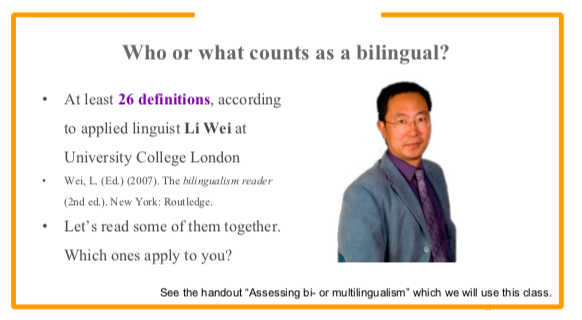
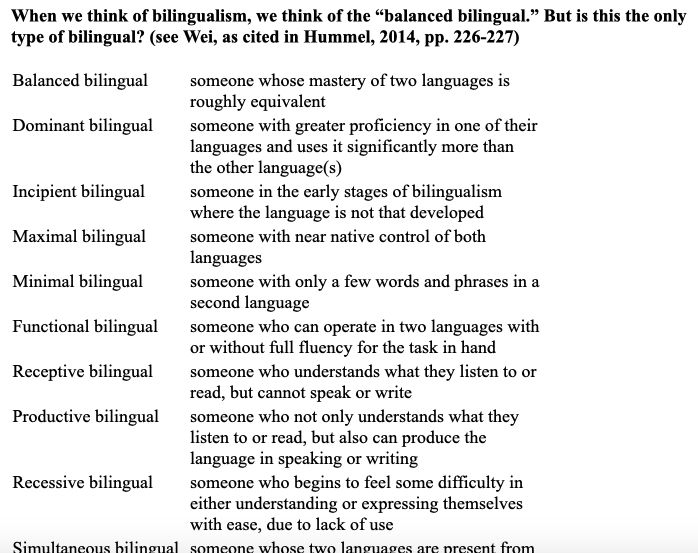
In this 2018 article on plurilingualism, Marshall and Moore state that “understandings of bi-/multilingualism have moved from the view of languages as separate, parallel, autonomous systems based on discourses of complete competencies to a view that recognises hybridity and varying degrees of competence between and within languages” (p. 3). They also state:
a person’s languages and cultures are not viewed as separate and compartmentalized but instead are seen as interrelating in complex ways that change with time and circumstances, and which depend on individuals’ biographies, lived experiences, social trajectories, and life paths (Coste et al., 1997, 2009). This view of languages and language use challenges the understandings of bilingualism presented earlier according to which individuals’ languages were thought as ‘separate compartmentalized worlds of existence’ (Lee & Marshall, 2012, p. 1) or ‘fixed and discrete entities’ (Taylor & Snoddon, 2013, p. 440). (p. 4)
So when a person has this interconnected repertoire of linguistic and cultural knowledge, it continues to develop throughout life and is never complete or incomplete; it just is depending on who that person needs to be at that point in time, given their age, geographic location, communities, networks, etc. Now, Marshall and Moore go on to say that just because plurilingualism is about individuals does not mean that plurilingualism is “all about the individual,” and doesn’t take into account larger social structures and barriers (p. 5). Of course people’s agency and language development is constrained by society. They give an example of three teenage students who were new immigrants to France: one was from Canada and a native English speaker; another was an economic migrant from Portugal; another had escaped violence and political chaos in Libya:
Due most likely to the social positions of the Arabic and Portuguese languages, associated with economic migrants who often carried out the jobs that the French did not want to do, as well as the additional association of Arabic with a perceived Islamist threat in France at the time, neither student was able to progress as well as the Anglophone Canadian. From day one, the Canadian student was surrounded by interested students who wanted to try out their English, ask for translations of rap music, and generally tap into the prestige of English as an International Language. (p. 6)
However, Marshall and Moore also point out that people have the agency to shape social structures within the classroom; for example, the teacher could do something about the situation. Therefore, they do not think that Kubota (2016) is justified in her criticism of plurilingualism, as she suggests plurilingualism is too much about individual agency and doesn’t take into account wider societal conditions. [Actually, as a former student of Kubota, I believe each article on plurilingualism is different; she is right that some studies of plurilingualism show “only the kind of diversity that privileges the multicultural/hybrid/cosmopolitan (rising) middle class over the monocultural/non-hybrid/parochial working class” (Kubota, 2014, p. 15, as quoted in Marshall & Moore, 2018, p. 7), but this is also true of translanguaging, and I think Kubota is aware of this.]
A second criticism that Marshall and Moore want to defend plurilingualism against is the idea that plurilingualism is TESOL-centered. In Europe, they point out that plurilingualism’s supporters also raise awareness of and promote minority, indigenous, and national languages (citing Cenoz & Gorter, 2015, among others). This is correct—plurilingualism research in Europe explores a variety of languages, some national, some minority, some indigenous. I personally am a fan of Hélot and Young (2002, 2005), who make a strong point of more actively promoting stigmatized minority and migrant languages, such as Turkish and Arabic, as well as other languages that students in Western Europe have little awareness of, such as Vietnamese. And Cenoz and Gorter do provide an excellent model of language revitalization of Basque. But again, this is up to the authors of individual studies: will they go beyond the official national languages?
Another argument that Marshall and Moore make is that, in countries like Switzerland, people do want to learn the dominant official languages like English, French, and German, particularly to succeed in their careers and feed their families (p. 7). Point taken. In a similar vein, they note that many Asian students are studying English in Inner Circle English-speaking countries, like their case study participant in the second half of their article.
The second half of the article is about Ah Yeon, a young woman enrolled in an English for Academic Purposes (EAP) class at a university in Canada. As they explain on p. 9, Ah Yeon came to Canada when she was 13 with her mother and brother while her father remained in Korea. She identified as Korean and a Canadian citizen, and reported that she still spoke better Korean than English and failed grade 12 English despite a 90%+ average in all other subjects, which is why she was enrolled in the EAP class. Marshall and Moore describe how her instructor and two native English speaker groupmates were supportive of her use of Korean to learn, and display of Korean in course projects, even though they didn’t understand it themselves, which “had a ripple effect as other groups added Mandarin, Arabic, and Farsi” on an assignment that involved argumentative editorial writing (pp. 9-12). Thus, Marshall and Moore conclude that “it would be an abdication on our part to not encourage Ah Yeon to learn what she needs and make her own informed, critical choices about what she wants to do with the [English] knowledge and competencies acquired” (p. 12), particularly when she, her teacher, and her classmates are agentively using plurilingualism to achieve their shared goals.
In other words, they conclude by suggesting some kind of balance between criticality and pragmatism: “We foster plurilingual competence where we can, cognizant of the constraints and high stakes involved for students” (p. 13).
García, O., & Otheguy, R. (2020). Plurilingualism and translanguaging: Commonalities and divergences. International Journal of Bilingual Education and Bilingualism, 23(1), 17-35. https://doi.org/10.1080/13670050.2019.1598932
The Cuban American education professors Ofelia García and Ricardo Otheguy, based in New York, are the leading proponents of translanguaging in the world, along with their Chinese-British colleague Li Wei. García and Otheguy’s article is in two parts and has a similar structure to Marshall and Moore’s. First, García and Otheguy explain what translanguaging has in common with the “panoply of lingualisms” (terms for multilingualism) and what sets it apart. Second, they discuss translanguaging in light of empirical evidence—in this case, four case studies of instructed language learners in different contexts.
They begin in quite a similar way to Marshall and Moore, discussing formal language education as often being monolingual or “one language at a time” (p. 18). Interestingly, they also discuss WHY that “one language at a time” mentality exists: it mirrors the language learning experiences of “elite” and voluntary bilinguals, or people who already belong to the dominant groups in society (e.g., middle-class English L1 Canadians or Americans). These people often don’t need to pick up other people’s languages unless they have to, which is not often—perhaps not unless they go to university, because in North American universities learning a foreign language is typically mandatory in the first two years (elementary classes in year 1, intermediate classes in year 2). Often, what these students of languages learn are standard versions of internationally valued languages with a history of empire and/or colonization: European languages (German, French, Portuguese, Spanish), Japanese, Chinese, Arabic, and often for their career benefit: “when schools have fostered bilingualism or multilingualism for their privileged citizenry, their work has been regimented by an additive ideology” (p. 18).
This is very different from a poor minority language speaker in an Odia-dominant region of India who has to learn Odia to survive in daily life, Hindi to do well in school, and English if they want to improve their social standing, and often uses these languages together in real life rather than in monolingually in a classroom setting, because the more languages are used together, the more it is because they are needed for daily survival, for practical reasons, not for monolingual school and tests and certifications. As another slap to the face, in many school systems, the minority language speaker (an immigrant or indigenous person) often has to “master” the dominant national language first at school before they can concentrate on learning other internationally valued languages through formal education; it becomes a matter of prioritization. This is why education professor Jim Cummins wrote:
Thus, we are faced with the bizarre scenario of [North American] schools successfully transforming fluent speakers of foreign languages into monolingual English speakers, at the same time as they struggle, largely unsuccessfully, to transform English monolingual students into foreign language speakers. (Cummins, 2005, p. 586)
The problem with world language education, according to García and Otheguy, is that it “places language outside the speaker, out in the ‘world'” (p. 19). Even in Africa, South Asia, and Southeast Asia, following the end of colonization, the same kind of monolingual language classrooms and proficiency tests are set up for the dominant languages of ruling ethnic groups (speakers of Hindi, Bahasa Indonesia, Tagalog, Swahili, etc.), while English-medium instruction tends to follow English-only policies (pp. 19-20). Even in language revitalization, “target language only” classroom policies may not mirror how students actually use their languages in real life—for an excellent treatment of this subject, regarding Quechua-Spanish bilingual education in Peru, see Zavala’s (2015) case study of a teacher who defied very elitist and culturally essentialist ways of teaching Quechua to value the plurilingual/translingual funds of knowledge of her bilingual students. In every formal educational context, there tends to be language separation policy that is constantly violated and negotiated by teachers and students (García & Otheguy, 2020, p. 20). And García and Otheguy rightly imply that the best scholarship on plurilingualism goes “beyond European languages and include[s] migrant languages to make children conscious of the linguistic diversity in their communities” (p. 22), citing Melo-Pfeifer (2015), Perregaux (1995), Candelier (2003) and Hélot & Young (2006).
García and Otheguy also explain how becoming bi/multilingual involves different identity processes for black/brown immigrants to Europe than for white Europeans born in Europe:
Plurilingual Europeans continue to be conceived of as ‘native’ speakers of a national language…. The national and linguistic identity of Europeans is not moved, even if their language repertoire expands to consist of what are considered bits of other national languages, creating speakers with broader horizons, and encompassing a more European persona. … In contrast, plurilingualism for black and brown refugees acts differently. A plurilingual education, in the limited cases where it exists, gives these students access to what is considered their ‘first language’ in order to integrate them linguistically to a ‘new’ and more valuable European national language. (p. 23)
Plurilingualism is an academically-grounded European Union language policy to develop skilled workers and immigrants competent in national languages; in contrast, translanguaging originated with minoritized Welsh language speakers (Baker, 2001; Williams, 1994) and is grounded in what Gloria Anzaldúa called the borderlands of bilingual minoritized communities (Anzaldúa, 1987). “Translanguaging focused on working with bilingual students to ensure that they were able to perform their bilingualism in ways that reflected who they were as bilingual beings” (García & Otheguy, 2020, p. 24).
I now get to the empirical section of the paper. García and Otheguy discuss four case studies:
- Christine, a French university student studying at a university in Madrid, who takes classes in Spanish as an Additional Language. Christine first develops good reading comprehension skills, and as months go by in which she is immersed in Spanish, she gets better at oral communication as well. She has friends who help her and instructors who are understanding, reading more for meaning than form.
- Mahmood, a 14-year-old refugee from Syria living in Sweden, who speaks Kurdish at home but was schooled in Arabic back in Syria. His classmates speak a wide range of languages: Arabic, Kurdish, Tigrinya, Tigre, Kurdish, Pashto, Persian, and Somali. The teacher is an inclusive educator who leverages students’ languages to give them access to Swedish.
- Danny, a Spanish-English bilingual kindergartener whose teacher “understands that he cannot (and should not at his young age) be forced to use only English or only Spanish during specific periods of time. She encourages his access to his full multimodal repertoire to select the most appropriate features to complete tasks…. How does Danny use language to ask and answer questions? To imagine? To tell a story? To say what he wants and how he feels? To say what is wrong? To solve a problem? To answer those questions she invites Danny not only to speak, but also to draw, sing, gesture, act. … Of course, Danny’s teacher understands that Danny will eventually have to acquire the sociocultural knowledge that prescribes which linguistic features are appropriate for which context and audience. But for now, she celebrates his ability to make meaning at all times” (p. 30).
- Alyssa, a student at a U.S. university near the Mexico border where 95% of students are Latinx, most of Mexican background. Alyssa’s teacher “provides the science textbook in both English and Spanish, and leaves it up to the students to select the text they want to use. … [S]he encourages oral interactions in which translanguaging is brought to the fore, and is convinced that this deepens discussions and allows everyone to participate. … She also encourages students to give oral presentations using their entire communicative repertoire, including multimedia, so as to maximize communication and understanding of all bilingual students in the classroom. … In addition, Alyssa’s science teacher encourages critical reflection about the role that English and Spanish have had in the frontera. Alyssa’s teacher believes that what is most important for a young transfronteriza is to represent herself as a bilingual for herself, not just for monolingual people on one side of the border or the other” (pp. 30-31).
Comparing plurilingualism and translanguaging
To sum up the two articles, we can see the similarity between plurilingualism and translanguaging is that they both see the individual language repertoire as holistic and integrated, rather than consisting of discrete and compartmentalized languages. One main difference is that plurilingualism still believes in the “reality” of distinct language codes, whereas translanguaging questions this (see also Li, 2018). A second key difference is that translanguaging articulates an explicit stance towards criticality and social justice, whereas plurilingualism is more cautious, balancing pragmatism and criticality.
Which term do I like more? The short answer is translanguaging, but once again (as I have stated many times in this blog) I don’t agree with Ofelia García on everything. I do believe in distinct languages. There are several reasons:
- Psycholinguistic evidence, as in the bilingual child’s ability to mix languages without breaking the grammatical rules of either (MacSwan, 2020), which shows “native-like competence,” but not in the form of double-monolingualism (one language at a time).
- Sociolinguistic evidence, which means that when people switch between Language A and Language B in conversation, they usually are shifting topic, task, phase of the conversation, or addressee, and the language switch signals this. A distinction between two codes is noted by participants in the conversation—this cues them that the “shifting gears” is taking place. Interactional sociolinguist Peter Auer (1998) called this code-switching.
- Domains of language acquisition, which means that even children growing up in very linguistically diverse societies where languages mix all the time still have domains of language learning, or particular languages learned for particular purposes but not others (Mohanty, Panda, Phillipson, & Skutnabb-Kangas, 2009).
Therefore, when it comes to epistemology (what I think about languages), I agree with plurilingualism. As a term, however, I still prefer translanguaging because I do think, properly understood, translanguaging has an explicitly critical stance. In fact, I am still not certain whether Marshall and Moore fully deal with the notion of “criticality.” They state that all teachers can do is give students access to dominant language and raise their awareness about linguistic inequalities; what students do with languages beyond the classroom is up to students (p. 12). Right. But what they miss, and what García and Otheguy express so clearly, is that translanguaging allows us to study how language is used by the vast majority of the world’s under-studied multilinguals. Marshall and Moore point out that European plurilingualism research is not just TESOL-centered, but they downplay its focus on the national languages of Europe, and in Canada, on French immersion and EAP, and often, the point of being in the class is still to acquire a societally dominant national or international language.
Even Ah Yeon is not part of the world’s multilingual majority, as she is in the world’s professional class Asian transnational minority that often gets studied in EAP. When we study the multilingualism of students like Ah Yeon who have been in Canada for so long (she came when she was 13, and is now a university student, in a city with many Korean residents) I believe we should study languages and cultures other than English and French as of Canada rather than just as “resources” students bring from their cultures to class—Korean, Cantonese, Farsi, Mandarin, Punjabi are languages of the Canadian university. Moreover, since dynamic translanguaging is something that the world’s many under-studied multilinguals do, and it is still stigmatized and seen as undesirable across formal education worldwide (García & Otheguy, 2020), we must continue to study more understudied multilinguals using a greater variety of languages in a greater variety of ways for a greater variety of learning aims.
At the same time that I criticize Marshall and Moore’s paper for not explicitly attending to the lack of diversity in which multilinguals we research and for what purposes, and how we frame their multilingual identities, I can also criticize García and Otheguy’s paper for not adequately dealing with course aims. The educational contexts they compare are sometimes incomparable—a small child being encouraged to express himself in any mix of English and Spanish as long as he exhibits appropriate behaviour in kindergarten, versus university courses in academic subjects or content area instruction in a national language; a class where 95% of students are from the same language and ethnic background (even if that is a cross-border one) versus a class with students from a wide variety of linguistic and ethnic backgrounds who only share the national language. This is where Marshall and Moore’s (2018) statement that we must be “cognizant of the constraints and high stakes involved for students” (p. 13) must still be addressed. How then should we choose between, or reconcile, plurilingualism and translanguaging?
Verdict: Plurilingualism as epistemology, Translanguaging as social and ethical stance, pedagogy based on needs analysis
In the previous section, I have explained why I think plurilingualism should be our epistemology (what we believe as the “reality” of languages: people have integrated, holistic repertoires that contain resources from different languages, and seeing languages as distinct as well as fluid allows us to think critically about social inequality, as I explain in this post on why translanguaging studies need to be complemented with studies on multivocality, borrowing, and stylization). The way we see students, however, should be based on a translanguaging stance, design, and shifts (see my summary of García, Johnson, & Seltzer, 2017, on how the design of bi/multilingual materials and the spontaneous “shifts” or choices in unfolding classroom interaction, which they call la corriente or the current, are based on a translanguaging stance that sees translanguaging as natural and desirable). Not only do we have to see students from an asset- rather than deficit-oriented perspective and elicit the use of their whole language repertoire in class—we have to be critical about whose multilingual practices we value, legitimize, and normalize; who we deem worthy of research; etc.
Now, even though a translanguaging stance is necessary in every classroom, pedagogy must also take into account needs analysis and course aims. And this is where we must ask what our learning outcome is. I propose the following cline for doing this.

When we think about Language Acquisition, we often think of a formal schooling context that has high-stakes assessments. This is where translanguaging supporter and critic Jürgen Jaspers (2018) has commented that K-12 teaching is a job that requires teachers to skillfully balance authority and equality; imparting knowledge and valuing students’ funds of knowledge, as I explain in this post. Students must increase their proficiency, which includes monolingual performance, in national and internationally prestigious languages, and the assessments may not mirror real world tasks; in fact there may be a great deal of uncertainty as to what the real world tasks in future may be. Two principles can still be followed: build many bridges between students’ existing funds of language/knowledge and the new language/knowledge to be acquired, and do not devalue anything students possess. Such a pedagogy, from teaching academic subjects in English as an Additional Language, was developed by Angel Lin for the Hong Kong K-12 context; called “Bridging Pedagogy” or the “Rainbow Diagram,” it is an approach that is quite generalizable across geographic locations. To see how the Rainbow Diagram works in practice, you can read this post.
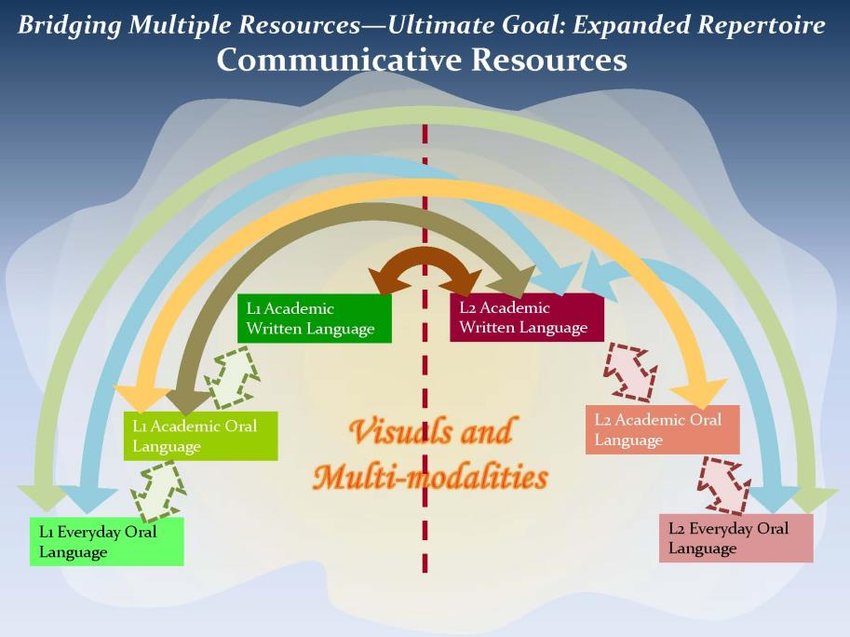
On the other side of the cline, Language Use, are community-based educational initiatives that foster literacy in order to get important things done, for example a grassroots COVID-19 information campaign in villages in southern Senegal run by the literacy organization LILIEMA (Lüpke, Sagna, & Weidl, 2021). LILIEMA teaches adults (many of whom failed to develop literacy in formal schooling because of its oppressive monolingualism and standardization) how to write translingually—and indeed, the adults successfully learned literacy skills for farm inventories, church congregation management, etc. These literacy skills involved translanguaging in writing, because that is how their society functioned, even though no school examination would require writing like that. For in the case of LILIEMA, the test is real life: were people adequately informed about COVID-19 through the translingual posters? But while classroom learning to some extent has to reflect real world needs, it cannot totally be 100% like the real world communication (which is more often translingual) because formal education has its own goals and social setting, which can be inclusive and critical in the hands of the right teacher, but does not budge on certain points like standardized assessments. This is why LILIEMA researchers explained in their webinar (which I summarize in this post) why grassroots education cannot be like school, and school cannot be like grassroots education.
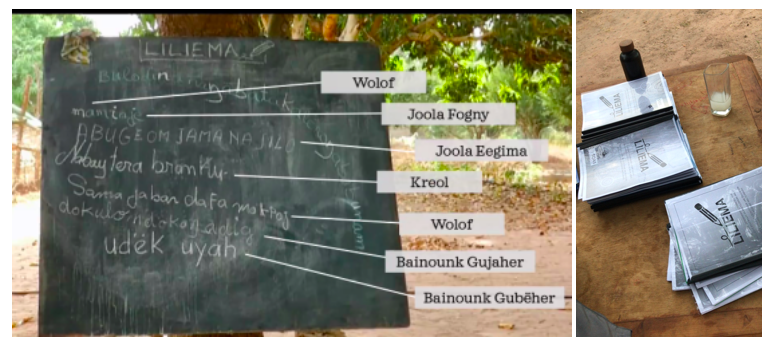
This brings us back to what we should be studying: translingualism in a host of different educational contexts, with a host of different populations, as García and Otheguy argue for, and with a critical orientation. Towards one end of the cline, we harness the whole language repertoire to promote language acquisition, sometimes for unclear future ends (Rainbow Diagram); towards the other end, we use the whole language repertoire for immediate community needs (example of LILIEMA). Thus, we must combine pedagogy based on needs analysis, a translanguaging stance (and design, and shifts), and a plurilingual epistemology to figure out what must be done to develop critical pragmatism in any educational context.
References
Anzaldúa, G. (1987). Borderlands/La frontera: The new Mestiza. Aunt Lute Books.
Auer, P. (Ed.) (1998). Code-switching in conversation: Language, interaction, and identity. Routledge.
Baker, C. (2001). Foundations of Bilingual Education and Bilingualism 3rd ed. Multilingual Matters.
Ballinger, S., Lyster, R., Sterzuk, A., & Genesee, F. (2017). Context-appropriate crosslinguistic pedagogy: Considering the role of language status in immersion education. Journal of Immersion and Content-Based Language Education, 5(1), 30-57. https://doi.org/10.1075/jicb.5.1.02bal
Bloomfield, L. (1933). Language. Holt, Reinhart and Winston.
Candelier, M. (Ed.) (2003). L’éveil aux langues à l’école primaire: Evlang: bilang d’une innovation européenne. De Boeck/Ducolot.
Cenoz, J., & Gorter, D. (2015). Multilingual education: Between language learning and translanguaging. Cambridge University Press.
Coste, D., Moore, D., & Zarate, G. (1997). Compétence plurilingue et pluriculturelle. Conseil de l’Europe.
Coste, D., Moore, D., & Zarate, G. (2009). Plurilingual and pluricultural competence. Council of Europe.
Cummins, J. (2005). A proposal for action: Strategies for recognizing heritage language competence as a learning resource within the mainstream classroom. Modern Language Journal, 89(4), 585-592. https://jstor.org/stable/3588628
García, O., & Li Wei. (2014). Translanguaging: Language, bilingualism, and education. Palgrave Macmillan.
Hélot, C., & Young, A. (2002). Bilingualism and language education in French primary schools: Why and how should migrant languages be valued? International Journal of Bilingual Education and Bilingualism, 5(2), 96-112. https://doi.org/10.1080/13670050208667749
Hélot, C., & Young, A. (2005). The notion of diversity in language education: Policy and practice at primary level in France. Language, Culture and Curriculum, 18(3), 242-257. https://doi.org/10.1080/07908310508668745
Hélot, C., & Young, A. (2006). Imagining multilingual education in France: A language and cultural awareness project at primary school. In O. García, T. Skutnabb-Kangas, & M. E. Torres-Guzmán (Eds.), Imagining multilingual schools: Languages in education and glocalization (pp. 69-90). Multilingual Matters.
Hummel, K. M. (2014). Introducing second language acquisition: Perspectives and practices. Wiley Blackwell.
Kubota, R. (2016). The multi/plural turn, postcolonial theory, and neoliberal multiculturalism: Complicities and implications for applied linguistics. Applied Linguistics, 37(4), 474-494. https://doi.org/10.1093/applin/amu045
Lee, E., & Marshall, S. (2012). Multilingualism and English language usage in ‘weird’ and ‘funny’ times: A case study of transnational youth in Vancouver. International Journal of Multilingualism, 9(1), 65-82. https://doi.org/10.1080/14790718.2011.595795
Li Wei. (Ed.). (2007). The bilingualism reader 2nd ed. Routledge.
Li Wei. (2018). Translanguaging as a practical theory of language. Applied Linguistics, 39(1), 9-30. https://doi.org/10.1093/applin/amx039
Lin, A. (2016). Language across the curriculum & CLIL in English as an Additional Language (EAL) contexts: Theory and practice. Springer.
Lüpke, F., Sagna, J. F., & Weidl, M. (2021, May 7). Inclusive multilingual literacy: The LILIEMA model. Talk for the Language and Sustainable Development Series, Universities of Botswana, Dar es Salaam, Essex, and Zambia.
MacSwan, J. (2020). Sociolinguistic and linguistic foundations of codeswitching research. In J. MacSwan & C. Faltis (Eds.), Codeswitching in the classroom: Critical perspectives on teaching, learning, policy, & ideology (pp. 3-38). Routledge.
Melo-Pfeifer, S. (2015). Multilingual awareness and heritage language education: Children’s multimodal representations of their multilingualism. Language Awareness, 24(3), 197-215. https://doi.org/10.1080/09658416.2015.1072208
Mohanty, A., Panda, M., Phillipson, R., & Skutnabb-Kangas, T. (Eds.) (2009). Multilingual education for social justice: Globalising the local. Orient Blackswan.
Perregaux, C. (1995). L’école, espace plurilingue. Lidil, 11, 125-139.
Taylor, S. K., & Snoddon, K. (2013). Plurilingualism in TESOL: Promising controversies. TESOL Quarterly, 47(3), 439-445. https://doi.org/10.1002/tesq.127
Williams, C. (1994). Arfarniad o Ddulliau Dysgu ac Addysgu yng Nghyd-destun Addysg Uwchradd Ddwyieithog [An evaluation of teaching and learning methods in the context of bilingual secondary education]. PhD dissertation. University of Wales, Bangor.
Zavala, V. (2015). “It will emerge if they grow fond of it”: Translanguaging and power in Quechua teaching. Linguistics and Education, 32, 16-26. https://doi.org/10.1016/j.linged.2015.01.009
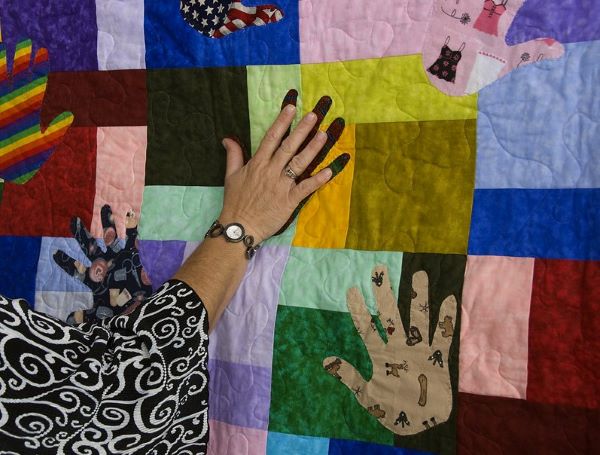
6 thoughts on “Plurilingualism vs Translanguaging: Epistemology, Stance, and Practice”
Comments are closed.